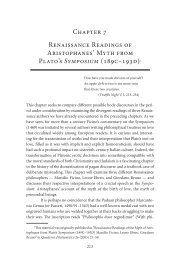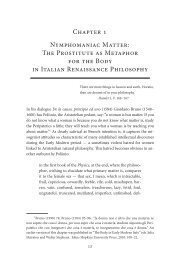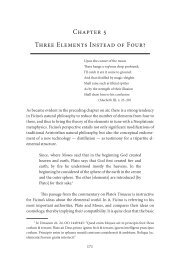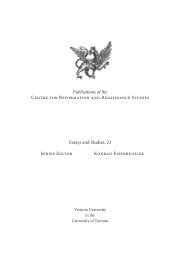Chapter 2 Matter as a Mirror: Marsilio Ficino and Renaissance ...
Chapter 2 Matter as a Mirror: Marsilio Ficino and Renaissance ...
Chapter 2 Matter as a Mirror: Marsilio Ficino and Renaissance ...
You also want an ePaper? Increase the reach of your titles
YUMPU automatically turns print PDFs into web optimized ePapers that Google loves.
<strong>Matter</strong> <strong>as</strong> a <strong>Mirror</strong> 103<br />
ever tarnish the images it once contained, neither would old age destroy them<br />
nor onslaught trouble them.” 172<br />
In an inversion that w<strong>as</strong> characteristic of European magical theory<br />
<strong>and</strong> practice, the mirror of providence found sinister uses. Powerful sorcerers<br />
were believed to have the capacity to trap the souls of the dece<strong>as</strong>ed (preferably<br />
the souls of recently executed criminals) in crystal bowls. Sometimes,<br />
these magical tools were even sold to be used by other persons, presumably<br />
less potent manipulators of images. 173 Although imprisoned into a mirror<br />
(like a soul into a body), the evil spirit (packaged in a bowl <strong>and</strong> turned into<br />
a commodity) nevertheless continued to lead a life of its own. 174 In his Disquisitiones<br />
magicae (1599–1600) the Spanish Jesuit Martin del Rio recounts<br />
the story of a Bordeaux lawyer who believed that he kept a spirit in a bottle,<br />
an indication that even educated people could adhere to these superstitious<br />
beliefs. 175 Other sceptical views about the demonic potentials of mirrors had<br />
been held at le<strong>as</strong>t since Roger Bacon’s De multiplicatione specierum, where<br />
the author says: “the opinion of the vulgar [m<strong>as</strong>ses], who hold that forms or<br />
species are impressed in the mirror <strong>and</strong> that vision by reflection is completed<br />
172 Cosmographia, cited after Dronke (1974) 123: “Erat igitur speculum providentiae,<br />
cuius magna admodum circunferentia, intermina latitudo, extensa superficies, prospicus<br />
introspectus, ut qu<strong>as</strong> diu contineret, imagines non rubigo deterret, non deleret antiquit<strong>as</strong>,<br />
non turbaret incursus.”<br />
173 For folk beliefs that demons actually resided in the magical instruments, see Roper<br />
(1994) 186: “Witches accused of using crystal balls for divination in late sixteenth-century<br />
Augsburg defended themselves by disclaiming any involvement in the production of the<br />
magical instrument, but they presented themselves rather like operators of pre-fabricated<br />
demons […]. As far <strong>as</strong> possible, crystal ball-gazers sought to distance themselves from the<br />
powerful, hypothetical sorcerers who had set up the balls; but their reluctance to claim<br />
power to conjure <strong>and</strong> their refusal to speculate on the mechanisms ultimately served to<br />
strengthen the belief that crystal magic did, in the l<strong>as</strong>t analysis, rest on the conjuration of<br />
very powerful spirits, by very powerful sorcerers.” See also, 133.<br />
174 On transparent things <strong>as</strong> “friends of light” <strong>and</strong> hence objects akin to mirrors see<br />
<strong>Ficino</strong>, In Theopr<strong>as</strong>tum de somniis chapt. 14, OO 1807: “diaphanum, id est transspiccum,<br />
& radiis undique pervium, & amicum, qu<strong>as</strong>i facilis hospes […].” On the function of the<br />
diaphane <strong>as</strong> universal medium of communication, even in opaque objects, see <strong>Ficino</strong>, In<br />
Theopr<strong>as</strong>tum de somniis chapt. 17, OO 1809.<br />
175 Disquisitiones magicae IV, 2 q. 6 sec. 4: reprinted in The Occult in Early Modern<br />
Europe 42.







